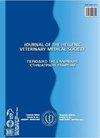百里香、有机酸、益生菌和益生元对正常和低蛋白质饲粮肉鸡胴体特性和肠道微生物群的影响
IF 0.4
4区 农林科学
Q4 VETERINARY SCIENCES
引用次数: 0
摘要
本试验旨在研究正常和低蛋白质饲粮中添加百里香、有机酸、益生菌和益生元对肉仔鸡胴体特性和肠道微生物菌群的影响。试验选用388只罗斯308肉鸡,采用完全随机设计,平均分为5个处理,每处理4个重复。实验处理为;1:对照组,2:百里香提取物(2公斤/吨),3:有机酸(3公斤/吨),4:益生菌(50克/吨),5:益生元(2公斤/吨),蛋白质水平正常和降低(比平时低10%)。42 d时,每个重复随机选择2只鸡屠宰,测定胴体率和胴体成分(大腿、乳房、肝脏、心脏、砂囊、脾脏、法氏囊、腹部脂肪和肠道)的活重。结果表明,与低于正常水平的饲粮相比,饲粮中粗蛋白质水平正常的饲粮提高了鸡脾脏和心脏的比例(P<0.05)。由此看来,腹腔脂肪的百分比与饮食中能量与蛋白质的比例有着密切的关系。肉鸡回肠pH含量在不同处理间及交互作用下均无显著差异(P >0.05)。此外,处理过的肉鸡回肠细菌种群也有不同的行为。随着益生菌的添加,回肠细菌的数量有所增加,这是可以预测的,因为饮食中含有有益菌。对比凋落物性状平均值,各处理与对照组无显著差异(P>0.05)。综上所述,在家禽营养的不同类型日粮中共同使用添加剂之前,应对添加剂的作用机理、与日粮其他组分的相容性以及安全性进行深入的研究。本文章由计算机程序翻译,如有差异,请以英文原文为准。
Effects of thyme (Thymus vulgaris), organic acid, probiotic and prebiotic on carcass characteristics and intestinal microbial population in broiler chickens fed with normal and low protein diets
The experiment was carried out to evaluate the effects of thyme, organic acid, probiotic and prebiotic on carcass characteristics and intestinal microbial microflora in broiler chicks in normal and low protein diets. A total of 388 Ross 308 broilers were equally assigned to 5 treatments with 4 replicates in a completely randomized design. The experimental treatments were; 1: control, 2: thyme extract (2 kg/ton), 3: organic acid (3 kg/ton), 4: probiotics (50 g/ton) and 5: prebiotics (2 kg/ton) with normal and reduced protein levels (10% lower than usual). At d 42, two chicks per replicate were randomly chosen, slaughtered and carcass percentage and carcass components percentage including a thigh, breast, liver, heart, gizzard, spleen, bursa of fabricius, abdominal fat, and intestine were determined for live weight. The results showed that using a diet with a normal level of crude protein compared to a diet with a level of crude protein lower than usual, increased the percentage of spleen and heart of chickens (P<0.05). It seems that there is a close relationship between the percentage of fat in the abdominal cavity and the ratio of energy to protein in the diet. Also, there were no significant differences between treatments and their interactions about pH content of ileum of broilers (P > 0.05). Besides, the bacterial population of ileum of treated broilers had different behavior. The ileum bacteria improved with probiotic addition and it was predictable because of beneficial bacteria inclusion to diet. Comparing the means for litter traits, no significant differences were observed between the experimental treatments with each other and with the control group (P>0.05). Totally, before the common use of additives in different types of diets of poultry nutrition, thorough investigations should be carried out on mechanisms, compatibility with other components of the diet and safety evaluation.
求助全文
通过发布文献求助,成功后即可免费获取论文全文。
去求助
来源期刊

Journal of the Hellenic Veterinary Medical Society
VETERINARY SCIENCES-
CiteScore
0.60
自引率
0.00%
发文量
83
审稿时长
>12 weeks
期刊介绍:
The Journal of the Hellenic Veterinary Medical Society (J Hellenic Vet Med Soc) is a quarterly peer-reviewed journal that publishes articles in all aspects of veterinary science and related disciplines. It is published by the Hellenic Veterinary Medical Society and is indexed in the Web of Science and in Scopus.
There are no publication fees in the journal. Authors considering submitting manuscripts for evaluation and publication are requested to read carefully the instructions for authors and fully comply with them.
Non-complying manuscripts may be returned to the corresponding author for formatting.
 求助内容:
求助内容: 应助结果提醒方式:
应助结果提醒方式:


